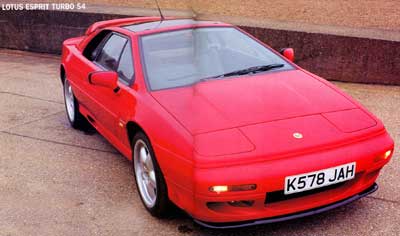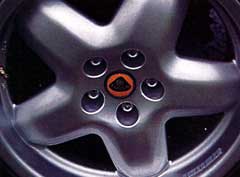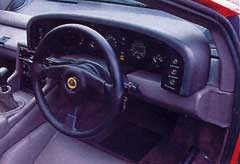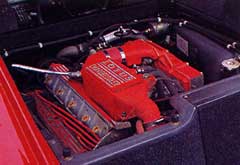

S4 Superior
Lotus's
sole survivor, the Esprit Turbo, has been revived.
We discover that the engineers' efforts have produced a fast car that really
is a joy to drive
Fast Lane April 1993
by Mark Hales
The engineers at Lotus would probably rather be building something to replace the ageing Esprit Turbo, rather than having to introduce a fourth version – the S4. But, with the untimely passing of the superb little Elan, the Norfolk concern is now a one product company and there was no option.
Fortunately for the enthusiast, changes wrought by the company's small and enthusiastic engineering team have been as much dynamic as cosmetic, and owe a great deal to the company's successful American race programme with the S3.
It always seemed odd that while the S3 (thing they mean the SE, LEW) was formidably fast, the missing ingredient was the joy which usually comes from driving a fast car. The sheer pleasure of handling the controls, and the delight in crisp and accurate response to inputs from the driver were hidden behind safety soft suspension and ploughing understeer. The chassis and suspension gurus who seemed able to fix everybody else's handling woes were, either content to ignore the incockpit appeal of their own cars, or had been required by management or marketing to produce something that they did not necessarily agree with.


Nevertheless the S3 held our record for road cars at Castle Combe race circuit for a long time, until the TVR Griffith muscled past last year. But it needed a great deal of bravery and physical effort from the driver to accomplish the feat. The car was phenomenally fast in a straight line, but gave no real, reassuring, initial bite at the corner. And when the full 260-odd chargecooled horsepower (guess it is the SE they are calling the S3, LEW) was unleashed in mid-corner, the nose would push ever wider until there was no choice but to lift off the power. Aggressive, understeer-combatant corner entry tactics like sudden release of brake pedal combined with an energetic heave of the wheel would lurch the car diagonally towards one front wheel, pick up the opposing rear and let it spin away the surplus power into a cloud of tyresmoke.
This was something of a dynamic safety valve, crude and incidentally effective, but there was little useful information coming back from the controls while any of it was taking place.
Steering was heavy – more saloon than sports car – yet there was plenty of unwelcome kickback from sharp road imperfections and a real willingness to follow white lines and ridges – especially when you were braking with the other hand on the gearlever. If you ever did succeed in provoking the car into oversteer, the steering wheel could suddenly spin opposite way with surprising force unless you remembered to hold it tight. This was all very well as a prompt to get the corrective lock applied smartish, but no so good if your thumbs happened to be in the way of a scything wheel spoke. It also took a good deal of muscle to haul the wheel straight and it is usually the failure to do this which causes the real accident, rather than the initial slide. None of it encouraged a precise driving style or offered any reward for harmony between man and machine.
For all that, the Lotus was extremely safe and rapid on the road.
While it might have dimmed any sparkle in the car's driving appeal, the Esprit's resistance to the usual mid-engined, on-the-limit desire to swap ends meant you had to persist to get yourself in trouble. And while self-respecting supertransport could boast six, eight or 12 cylinders, the Esprit's four pots made for a short, light power unit which in turn allowed the designers to keep major masses further forward of the tail. This is one of the reasons why the Lotus is ultimately reluctant to bite a careless handler, unlike the Porsche 911.
The Lotus engine was and still is a little rattly at tickover, but the 2.2-litre 16-valve engine is exceptionally smooth in serious operation and the blower installation is one of the best, with little delay in response to the throttle. At 4,000-7,000rpm overtaking punch is simply massive. The factory's claim of 264bhp always felt conservative. It appears that the characteristics of the chargecooler – the liquid to gas heat exchanger that cools the fuel-air mixture going into the engine – can allow over 280bhp when the ambient temperature is low. The hierarchy had apparently been quoting power output figures based on air temperatures in Arizona, in an attempt to appear ecologically reasonable.
The S4's engine is mechanically unchanged, although the electronic management has been revised in to make the turbo come in even more quickly than before. There is only so much you can do while the turbo is spinning up, and while you certainly notice the difference, I could not help feeling the older system had a more progressive, classy feel to it.
Power steering is the major mechanical difference between the S3 and S4 (definitely mean the SE, LEW), and while this may mot sound much, it opens up a whole range of aggressive geometric options which would otherwise increase steering effort from heavy to completely impossible. Engineering chief Roger Becker is surprisingly candid about the changes, admitting that for the S3 (I'm going to change it to SE from now on, LEW) evolution, they had probably listened a little too hard to some of their dealers who didn't understand the dynamics and wanted the car to ride more softly to please certain customers. After launch, Lotus realised the design team had made the springs too soft, the dampers too stiff, and built a pro-drive characteristic into the front suspension which encouraged the car's nose to dip too readily under cornering or braking.
In Becker's words, the SE needed tightening up right from the beginning.
But if they knew that in 1989 (See told you they were talking about the SE and not the S3, LEW), why has it taken until now to get around to power assistance? Becker points out, rather wearily, that the addition of power steering was not just a matter of changing the steering rack, and that the company's extensive experience with other people's steering problems made them wary of getting involved with the wrong item. Also there was no real money available for development. Marriage to GM has certainly helped, with access to a corporate parts bin which yielded enough Saginaw rack parts from all sorts of unlikely applications, to do the job.
Maybe it was worth the wait because the difference the power steering makes is simply amazing. The S4 displays more bit at the front as soon as you ease out of the car park, and as the speed builds, you begin to feel that delicious, permanently on-rails feeling as you guide the newly sculptured steering wheel with fingertips, rather than white knuckled fists. You don't need to worry about one handed braking any more either, because the powered rack also performs a damping function, softening and slowing any aggressive kickback or self centring that the extra castor and negative camber might otherwise throw at the car's helm. Enough still filters through to give the driver some feel of the road, and thankfully there wasn't anything in the bin to devise any of the ghastly but voguish, speed-variable assistance.
Just as it does with the Lamborghini Diablo VT, the newly assisted steering gives a whole new level of driver confidence and ease of control. There is a great sense of eagerness about the car's response and it has been accomplished without making the thing feel nervous like Ferrari's 348.
Stiffer springs front and rear – with new non-gasfilled dampers – and anti-dive geometry complement the new rack and keeps the car's nose up, adding to the sense of poise and control. On the Lotus test track, the sort of corner which would have had the SE ducking, diving and wheelspinning allows the S4 to be held in the sort of lazily balanced power slide you though went out with the 3-litre Capri.
Judging by feel alone, it is difficult to believer that this is the same basic car. Increasing the spring rates inevitably makes the ride knobblier than before, but surprisingly, it is more comfortable than it was because the car stays flatter and more composed, and the body does not move so far on the springs.
To complement the suspension changes, Goodyear has developed some unique 40 and 45 profile asymmetric 17-inch tyres to replace the SE's 15 inchers and these are fitted to specially designed aluminium-alloys. The large diameter wheels – as with the Ferrari 512 – make the car look more elegant and purposeful. Big wheels spell performance, tall tyres spell comfort.
The S4 driver will also notice a much improved gearshift to the Renault 25 gearbox, and this was a direct legacy of the company's Stateside IMSA race effort. Lotus speaks warmly of its relationship with the French giant, and there is a new and stronger gearbox case with a revised cable linkage which gives a much shorter and more precise throw at the lever. No longer do you change the radio station with your knuckles as you seek third gear. There is still no limited-slip differential fitted to the final drive, but since the suspension controls the attitude of the chassis so much better it is hardly necessary.



Inside, there are new Vauxhall stalks, eyeball vents and a new instrument binnacle which sites the major instrument lower and allows the driver to see the most important 70-100mph and 3-5,000rpm information on speedo and tacho. Seats are restyled and there is a completely new door assembly with one-touch windows. Gone at long last are the Marina door handles, and there is now one-key central locking with an alarm and immobiliser as standard. At the rear, a new wing offers a 'better aerodynamic balance' – slightly less lift with slightly more drag. The restyled front has purely cosmetic revisions to the air intakes which feed air from the sills to the engine.
It's a fresher looking, better handling Esprit, that is much nicer to drive. The price is still £46.995 and probably the biggest problem that Lotus face is what else you can by for the money.
|
|